The VMM took a road trip a few weeks ago, and journeyed down to the Jersey Shore to share some retro goodness at the Vintage Computer Festival East. The ninth running of the VCF East was held April 4-7 at the InfoAge Science Center in Wall, New Jersey, and the Vintage Mac Museum was an exhibitor.
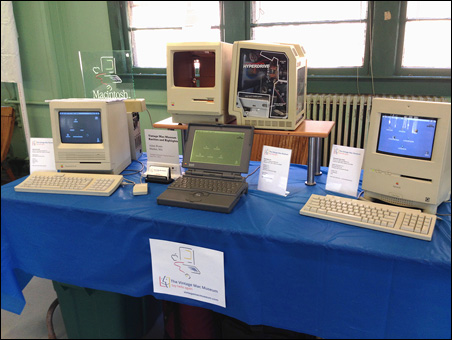
VCF East is hosted by MARCH, the MidAtlantic Retro Computing Hobbyists group. The show featured a wide range of computing history, from a seminal, room-size UNIVAC computer, through the DEC, Prime and HP minicomputer era, to the workstations and home computers of the 1970s and ’80s. Apple made a good showing, including a number of Apple 1s, a few Apple IIs, one working Lisa 2 and several tables of Macinti.
At the Vintage Mac Museum table (next to the Univac), I showed off three working models that attendees could interact with – an SE/30, a PowerBook 170, and a Color Classic. Based on comments received I think every Macintosh owner over 35 once owned some variant of a Mac SE! Each system was also loaded up with the appropriate After Dark screen saver module – running the Fish module on the Color Classic makes a great Virtual Macquarium! In the back row was a Macintosh Picasso Dealer Sign, an empty compact Mac shell lit to show the signatures inside, and a Mac 512k with clear plexiglass side panels.
Definitely a fun (and geeky) event. Interest in the computers of yesteryear continues to increase, and is reflected in a growing number of vintage computing events around the country. To read more at about the show see Cult of Mac: Vintage Computer Festivals Rock On, VCF East 2014 Larger Than Ever.
It seems now that Steve Jobs has been gone for a few years, and Apple hasn’t released any market-defining products in the same timeframe, an atmosphere of doom and gloom has once again settled over the press. 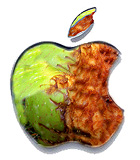 Apple has lost its way, they can no longer innovate and are coasting on past glories. Their tasteful and well received look back at the Mac at 30 was viewed by some as a sign of rot at the core. Instead, clearly, they should do ______ (fill in the blank).
Apple has lost its way, they can no longer innovate and are coasting on past glories. Their tasteful and well received look back at the Mac at 30 was viewed by some as a sign of rot at the core. Instead, clearly, they should do ______ (fill in the blank).
Apple is one of the most profitable companies around, yet every time they announce a profitable quarter their stock goes down! Well we’ve been here before, and frankly I’m not too worried. The Apple of today is far different than that of the mid 1990s. Most companies would give anything to have Apple’s revenues and profit margins. But Apple is not most companies, even if Wall Street thinks they should be.
Since last year Apple has been running an ad campaign along the theme Designed by Apple in California. One video has not aired publicly, but rather was only shown at the 2013 World Wide Developers Conference. It’s called Designed by Apple – Intention and is the single clearest statement I’ve seen about understanding who Apple currently is and what drives them. I wish they had aired this spot during the Super Bowl:
Apple is a for-profit company, but that’s not their only driving force. They strive for excellence in design and execution, and generally achieve it. Apple products touch peoples lives in ways few other companies do. Former Wall Street Journal reporters and profit-at-all-costs advocacy groups like the NCPPR may think that Apple is doomed. That’s their right. For my part, I’m not worried.
Image Credit: ZDnet
The Macintosh Plus was Apple’s longest produced 68k Macintosh. It was introduced in January 1986 and discontinued in October 1990. During that timeframe Apple introduced a new design look for its products called the Snow White design language, exemplified in the striped case designs of the Macintosh II and SE. They also changed the case color from Beige to Platinum.
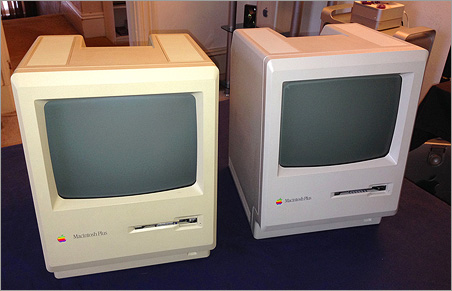
I recently acquired a pair of these Macs, one in each style. Side by side the color difference is quite notable. The very first Macs were beige in color (officially known as Putty), not quite as yellow as they’ve become today but still definitely a shade reminiscent of old khakis. The original Macintosh, Mac 512k and Mac Plus all used this color case. Then in 1987 Apple started using the lighter color they called Platinum.
Apple kept the Mac Plus around as the low end model when the SE was released (it was the cheap iPhone of its day), but they didn’t want the system to look outdated next to newer machines. So Platinum it was. In addition to changing the color, as Apple began to offer 2MB and 4MB configurations, the label on the back dropped the 1MB memory designation. And the shipping box itself also changed, from one using a color product photo and six-color Apple logo to a black & white drawing and a red logo.
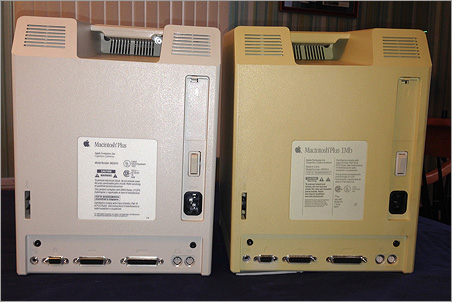
With SCSI and expandable RAM the Plus was the first truly successful Mac design. Many remained in service well into the PowerPC era. Today Apple would phase in a color change along with a new model release (e.g., the black iPhone becomes space grey), but back in the day things were a bit more casual.
What color is your Mac Plus?
Posted on February 15th, 2014 in
Vintage Mac Museum Blog |
10 Comments »
So it was quite a whirlwind of activity last week as the Macintosh turned 30. After browsing all the coverage and commemorative efforts dedicated to the occasion, here are a few standout things which I think are worth remembering and revisiting: 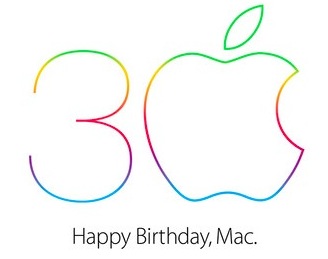
Apple: Thirty Years of Mac
Apple takes a moment to look back on three decades of their longest running product line. Creating a special mini website with commemorative video, a historical Macintosh timeline, and interactive polling and feedback, the Mothership finally reflects.
Yes indeed, the Post Jobs era has now officially begun.
CNET: The Macintosh Turns 30: Going the Distance
Dan Farber does a fabulous job documenting the birth of the Macs, its initial challenges, and the long road Apple and Steve Jobs’ prodigal son have taken from 1984 to the present. Part of CNET’s Mac at 30 coverage, it’s extensively detailed and well worth a read.
iFixit: Macintosh 128k Teardown
iFixit, Cult of Mac and (yours truly) the Vintage Mac Museum join forces to create an insanely great teardown of the original Macintosh. See how it was all put together back in the day! iFixit notes:
Ye olde CRTs were a mixed bag for repair purposes—easier to access than today’s tight-fitting flat panel displays, but boy were they dangerous if mishandled… Between the CRT and the capacitors, disconnecting this power supply sort of feels like disarming a bomb.
AppleInsider: Apple’s Macintosh has forced the world to change for 30 years
A long and thoughful essay by Daniel Eran Dilger on how the Mac has evolved over time, continuing to innovate and impact computing three decades after its creation. Somehow the Mac is always on the Verge of Doom and going in the wrong direction, yet Apple is now stronger than ever!
Computer History Museum: The Very First ‘Stevenote’
The first public exhibition of the Macintosh took place on January 30, 1984 at a meeting of the fledgling Boston Computer Society. The BCS videotaped the event, and former president Jonathan Rotenberg tells the tale of the remarkable demonstration – the world’s first ever Stevenote!
Shrine of Apple: Celebrate the Mac
And last but not least, Jonathan Zufi (author of Iconic) turns his photographic eye to the Macintosh, and produces another beautiful gallery. Feast your eyes on photos like these of Macinti across the ages…

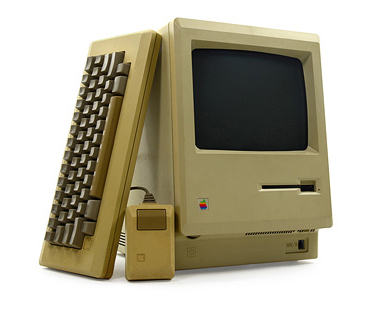
Today is the 30th anniversary of the launch of the Apple Macintosh. As we all know, on January 24, 1984, Apple computer introduced Macintosh. And we saw why 1984 wouldn’t be like 1984.
Happy 30th Birthday Macintosh!
As you might imagine, it’s been getting a bit of press. To help with the coverage, it’s also been a busy past week behind the scenes at the Vintage Mac Museum.
Last weekend a photographer from Reuters stopped over the house to take some photos of the original Mac. We set one up and played around with MacPaint and MacWrite for a while, looked at the packaging and accessories, etc.. A few of these photos along with comments were posted to the Reuters newswire for use in support of the anniversary.
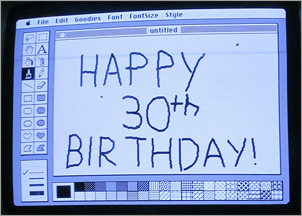 These started appearing yesterday internationally!
These started appearing yesterday internationally!
• The Baltimore Sun (USA)
• Business Today (USA)
• The Calgary Sun (Canada)
• Malay Mail Online (Malaysia)
• GMA News Online (The Phillipines)
• Kaleej Times (United Arab Emirates)
• The Peninsula Times (Qatar)
In addition to that, the VMM, iFixit and Cult of Mac teamed up to do a teardown of the original 128k Mac as a special anniversary repair guide. The Museum supplied the (non-working) sacrificial Mac for dissection. They did a great job, it’s well worth a read – very entertaining.
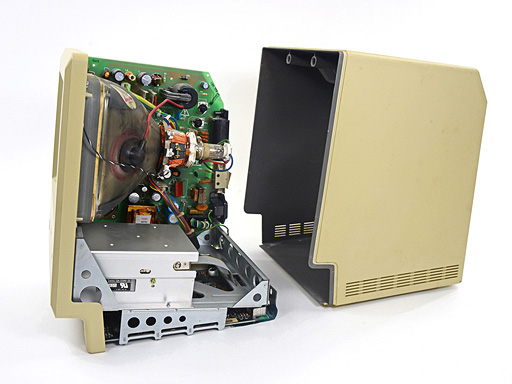
Here’s to another 30 years of Macintosh – and hoping it’s insanely great!
Sometimes when you open your email, you receive unexpected news. And sometimes that news itself is of an unexpected find. Recently I got a note from a visitor to the Vintage Mac Museum describing a rather unique piece of Apple memorabilia:
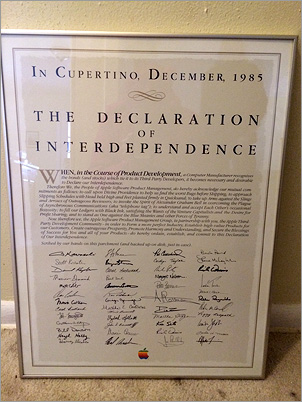
I found this for my husband’s Christmas gift at a second hand store. It’s a poster titled The Declaration of Interdependence from 1985, and is in what I think is the original aluminum frame. It’s an awesome piece of Apple history […] I don’t know how many were made.
I wish second hand stores in my area had items like this!
I haven’t seen this poster before. I suspect it was a short lived creation. December 1985 was only a few months after Steve Jobs left the company, the Mac wasn’t selling well, and morale needed a boost. You don’t want to piss off your developers when growing a new platform, and Jobs was famous for his temper and demands. This tongue-in-cheek parody of the US Declaration of Independence shows both Apple’s cockiness and acknowledgement of reality in developing their products.
There isn’t much information online about the poster. The New York Times mentioned it briefly in a 1997 article, and the Computer History Museum has a copy in its archives. The full text reads:
In Cupertino, December 1985
THE DECLARATION OF INTERDEPENDENCE
When, in the Course of Product Development, a Computer Manufacturer recognizes the bonds (and stocks) which tie it to its Third-Party Developers, it becomes necessary and desirable to Declare our Interdependence.
Therefore We, the People of Apple Software Product Management, do hereby acknowledge our mutual commitments as follows: to call upon Divine Providence to help us find the worst Bugs before Shipping; to approach Slipping Schedules with Head held high and Feet planted firmly in Quicksand; to take up Arms against the Slings and Arrows of Outrageous Reviewers; to invoke the Spirit of Alexander Graham Bell in overcoming the Plague of Asynchronous Communications (aka “telephone tag”); to understand and accept Each Other’s occasional Bozosity; to fill our Ledgers with Black Ink, satisfying the Wants of the Venture Capitalists and the Desire for Profit Sharing; and to stand as One against the Blue Meanies and other Forces of Tyranny.
Now therefore we, the Apple Software Product Management Group, in partnership with you, the Apple Third-Party Development community – in order to Form a more perfect Industry, Establish high-value Products for our Customers, Create outrageous Prosperity, Promote Harmony and Understanding, and Secure the Blessings of Success for You and all of your Products – do hereby ordain, establish, and commit to this Declaration of Our Interdependence.
Scribed by out hands on this parchment (and backed up on disk, just in case).
Pithy and Insightful! I don’t recognize most of the signatures, but the first one is Guy Kawasaki. He was an official Apple “evangelist” at that time, helping to rally customers and developers to the cause. I definitely suspect this was one of his projects. Certainly a fun thing to hang on your cubicle wall!
If any readers know more about the history of this item, please leave details in the comments.
Photo Credit: Katie Graham

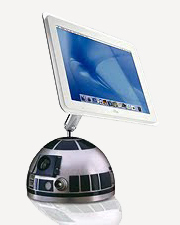

 Apple has lost its way, they can no longer innovate and are coasting on past glories. Their tasteful and well received look back at the
Apple has lost its way, they can no longer innovate and are coasting on past glories. Their tasteful and well received look back at the 






